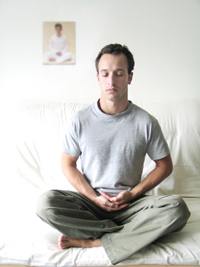by guest author Peter Fernando, Meditation and Mindfulness
Are you wanting to start your own home meditation practice? The number one piece of advice I have for you is: Just do it!
Having said that, a recent question that came in asked for more details, so in response to that reader, here’s…
Six Useful Home Meditation Tips
1) Don’t meditate in front of the TV (even when it’s off), or in front of the computer.
If you take some time to create a meditation-only space in your home, it’s more likely you’ll enjoy the experience, and not feel distracted and antsy. You can use any images or objects you find remind you of stillness, or peace, when creating this space.
2) Abide by the pleasure principle.
If it starts feeling terrible, STOP. At least in the beginning. There’s no point trying to ‘break through the pain barrier’ when you’re just starting out. Psychologically speaking, we will tend to gravitate towards that which is pleasant. So, if we have the memory of meditation as some kind of dramatic battle, it’s likely that we’ll try to avoid it like the plague.
3) Use a timer, and start with short times.
10 minutes is a manageable time to start with. If it feels comfortable, you can increase the time incrementally. But don’t force it. Humble steps work better in the long run.
4) Don’t force your body into an elaborate sitting position if you have an injury, or if it feels painful.
I did this, when I was 22, and screwed up my right knee trying to do full-lotus without being properly prepared. I learned the hard way that there is nothing sacred in a posture. Sure a meditation posture can definitely help to circulate energy and generate ‘fire’, but it’s not absolutely so. So if you have an injury, please don’t feel bad if you have to sit on a chair, or stool. As long as your back is upright, and your belly is open, it’s good enough to meditate.
5) If you are comfortable sitting on the floor, it really helps to keep your knees on the ground, with your buttocks raised higher then them, on a cushion.
If you have your knees higher than your buttocks, you get weird circulation things happening, which makes the experience rather unpleasant!
6) Don’t spend too much time worrying whether you are ‘doing it right’ or not.
There is no one judging your practice, and no ‘meditation police’ that are going to issue you a ticket! There are, however, techniques that are useful for anchoring the mind in the present moment, and holding up a mirror to our patterns of thought. See below…
Techniques are really useful for getting practice going, especially when we’re just starting out.
The first, and most widely used, is ‘Mindfulness of Breathing‘.
There are literally hundreds, if not thousands of free guided breath meditations you can download. Everyone has their favorites.
I would recommend visiting Gil Fronsdal’s site, audiodharma.org for a collection of practical, non airy-fairy guided breath meditations to help you get started. The site, dharmaseed.org also has hundreds of really good meditations. If you type ‘breath’ into the search bar, you’ll get all that they have to offer!
Another one is what’s called ‘Body-Scanning‘.
It’s basically a way of coming out of the head (where a lot of us may spend our day, working in an office and so forth), and into the direct felt sense of the body. You will find that there is an inherent quality of calm and relief that comes from this kind of meditation.
Try it and see! The websites above will have many to offer as well, all for free.
I would also add that the attitude you bring to the cushion will go a long in way in terms of getting meditation going in a way that feels natural and authentic for you.
If there is an attitude of real interest – a real curiosity about what this mind of ours is, and particularly how it departs from the present moment, in favour of ideas of the past, future and parallel universes right now, then we’re less likely to kid ourselves.
You could call this sincerity. It’s a kind of authenticity of intention, I reckon. A heartfelt desire – no – need to meditate.
It’s like when we’re hungry: eating isn’t just a good idea among other ideas, it’s the only appropriate response. Meditation works best if it’s coming from a similar place. Kind of like;
‘I’m so hungry for peace, for rest, for stillness, for some clarity in the midst of this tangled web I call my mind and heart. I need to sit!’
You may not have this particular hunger.
Or maybe you have other ways of coming back into the stillness and silence of being. That’s all good too.
But I’m kind of assuming that if you’ve read this far, you’ve felt the hunger. At least a little bit. Sometimes we only feel it when we’re really having a bad time, but then life gets OK again, and the hunger for a deeper peace goes away… But that’s another story.
So that’s a few thoughts on beginning a meditation practice at home. Please drop me a line if there’s anything that’s not clear, or that I can elaborate upon. I am most happy to help!


I am a housewife and mother, so can i start with meditation in night when everybody goes to sleep because for me that is the time for me ?
Hello Sonali,
Yes, yes and yes. If that’s your time, that’s the time to start a meditation practice.
Enjoy,
KL
This is so inspiring. From today I start to do meditation everyday.
Thank you for your suggestions. Here I go ❤️